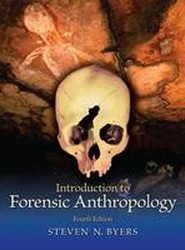(To see other currencies, click on price)
MORE ABOUT THIS BOOK
Main description:
A comprehensive overview of forensic anthropology Comprehensive and engaging, Byers's Introduction to Forensic Anthropology, 5/e uses thoughtful pedagogy to lead students step-by-step through the most current and detailed forensic anthropology material available today. This one-of-a-kind book offers comprehensive coverage of all of the major topics in the field of forensics with accuracy, intensity, and clarity. Introduction to Forensic Anthropology emphasizes the "hows" of the field, leaving the "whys" unexplored. Features are described as they relate to the forensic anthropological processes, not from an anatomical and evolutionary standpoint. Students must first understand what "typical" specimens looks like before approaching how individual specimens can vary from the norm. Extensive illustrations and photos ensure that the text is accessible for students. MySearchLab is a part of the Byers program. Research and writing tools, including access to academic journals, help students explore forensic anthropology in even greater depth. To provide students with flexibility, students can download the eText to a tablet using the free Pearson eText app.
NOTE:MySearchLab does not come automatically packaged with this text. To purchase the text with MySearchLab, order the package ISBN: 0133827887 / 9780133827880 Introduction to Forensic Anthropology Plus MySearchLab with eText -- Access Card Package Package consists of: 0205239927 / 9780205239924 MySearchLab with Pearson eText -- Valuepack Access Card 0133772020 / 9780133772029 Introduction to Forensic Anthropology ALERT: Before you purchase, check with your instructor or review your course syllabus to ensure that you select the correct ISBN. Several versions of Pearson's MyLab & Mastering products exist for each title, including customized versions for individual schools, and registrations are not transferable. In addition, you may need a CourseID, provided by your instructor, to register for and use Pearson's MyLab & Mastering products. Packages Access codes for Pearson's MyLab & Mastering products may not be included when purchasing or renting from companies other than Pearson; check with the seller before completing your purchase.
Used or rental books If you rent or purchase a used book with an access code, the access code may have been redeemed previously and you may have to purchase a new access code. Access codes Access codes that are purchased from sellers other than Pearson carry a higher risk of being either the wrong ISBN or a previously redeemed code. Check with the seller prior to purchase. --
Contents:
In This Section: I) Brief Table of Contents II) Detailed Table of Contents I) Brief Table of Contents Chapter 1. Introduction. Chapter 2. Basics of Human Osteology and Odontology. Chapter 3. Establishing the Forensic Context. Chapter 4. Recovery Scene Methods. Chapter 5. Estimating Time Since Death. Chapter 6. Initial Treatment and Examination. Chapter 7. Attribution of Ancestry. Chapter 8. Attribution of Sex. Chapter 9. Estimation of Age at Death. Chapter 10. Calculation of Stature. Chapter 11. Death, Trauma, and the Skeleton. Chapter 12. Projectile Trauma. Chapter 13. Blunt Trauma. Chapter 14. Sharp and Miscellaneous Trauma. Chapter 15. Antemortem Skeletal Conditions. Chapter 16. Postmortem Changes to Bone. Chapter 17. Additional Aspects of Individualization. Chapter 18. Identification Using Antemortem Records. Chapter 19. Conclusion. II) Detailed Table of Contents Chapter 1. Introduction. Historical Background. Forensic Anthropologists and the Medicolegal Community. The Forensic Anthropology Protocol and Methods in Forensic Anthropology. Chapter 2. Basics of Human Osteology and Odontology. Overview of the Human Skeleton. Basic Topics in Osteology. Overview of the Human Dentition. Chapter 3. Establishing the Forensic Context. Bone versus Non-Bone. Human versus Non-Human. Contemporary versus Non-Contemporary. Chapter 4. Recovery Scene Methods. Preliminary Issues. Locating Remains. Mapping Remains. Grave Excavation. Collecting Remains. Mass Disasters. DMORT. Chapter 5. Estimating Time Since Death. Overview of Decomposition. Decomposition and Skeletonization. Animal Scavenging. Other Methods. Chapter 6. Initial Treatment and Examination. Forensic Anthropology Laboratory. Preparation of Remains. Reconstruction, Sorting, and Re-Assembly. Inventorying Remains. Chapter 7. Attribution of Ancestry. Anthroposcopic Traits. Metrical Methods. Miscellaneous Ancestral Characteristics. Chapter 8. Attribution of Sex. Sexing the Pelvis. Sexing the Skull. Miscellaneous Methods. Sexing Subadults. Chapter 9. Estimation of Age at Death. Subadults. Adults. Chapter 10. Calculation of Stature. Basics of Stature Reconstruction. Full Skeleton Methods. Long Limb Bones. Other Skeletal Elements. Partial Long Limb Bones. Adjustments to Stature. Chapter 11. Death, Trauma, and the Skeleton. Cause and Manner of Death. Basics of Bone Trauma. Characteristics of Forces Causing Trauma. Types of Trauma. Timing of Bone Injury. Chapter 12. Projectile Trauma. Basics of Ammunition and Firearms. Effects of Bullets on Bone. Bullet Wound Analysis. Pellet Wound Analysis. Miscellaneous Projectiles. Cause and Manner of Death. Chapter 13. Blunt Trauma. Characteristics of Instruments. Types of Fractures. Effects of Blunt Instruments. Wound Analysis. Cause and Manner of Death. Chapter 14. Sharp and Miscellaneous Trauma. Sharp Trauma. Strangulation. Chemical Trauma. Cause and Manner of Death. Chapter 15. Antemortem Skeletal Conditions. Pathological Conditions. Skeletal Anomalies. Occupational Stress Markers. Chapter 16. Postmortem Changes to Bone. Dismemberments. Animal Scavenging. Fire Damage. Weathering. Burial Damage. Water Transport Damage. Miscellaneous. Chapter 17. Additional Aspects of Individualization. Facial Reproduction. Assessing Handedness. Estimating Body Weight. Chapter 18. Identification Using Antemortem Records. Radiography. Photographic Superimposition. Forensic Odontology. Miscellaneous. Chapter 19. Conclusion. Ethical Responsibilities. The Final Report. Courtroom Testimony. Future of Forensic Anthropology. Short Retail Description
Publisher recommends


